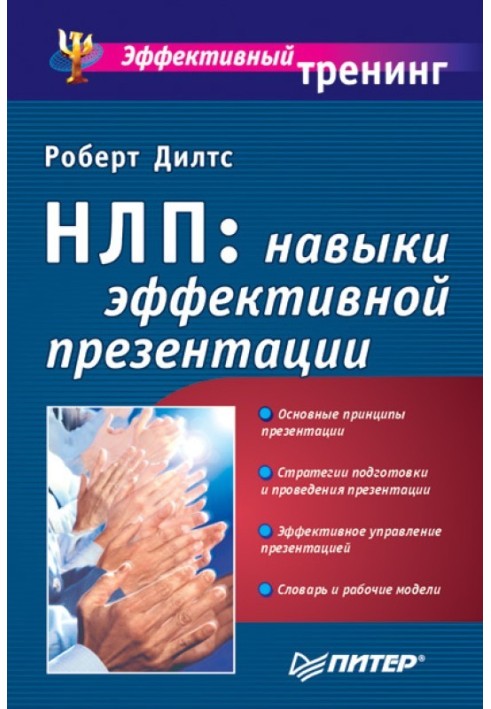NLP: Effective Presentation Skills
 Instant download
Instant download
after payment (24/7)
 Wide range of formats
Wide range of formats
(for all gadgets)
 Full book
Full book
(including for Apple and Android)
The work of one of the leading experts in the field of NLP is devoted to key issues of managing communications and relationships in the context of presentation. The publication examines the main aspects of organizing, evaluating and conducting an effective presentation. The material in the book is structured and presented in a form that allows, from the author’s point of view, to best present the main axioms, principles, teaching methods and presentations based on neuro-linguistic programming. The book is addressed to executives, psychologists and anyone interested in the practice of NLP.
The problem space of effective presentationsBasics of presentation planningUse of various representative channelsStrategies for creating referent experience
Establishes a general framework for defining and research on effective presentation skills in relation to: 1) establishing cognitive maps; 2) creating relevant referent experience; 3) understanding one's own conscious and unconscious competence associated with giving a presentation; 4) identifying and observing these processes in other people. Presentation skills and organizational learningThe presentation problem space in the context of learningImproving presentation skills
Offers a set of models and distinguishing features that will allow the reader to identify the different levels of structure of his skills and presentation style and identify principles for planning an effective presentation.Macrostructure of experience and learning: the TOTE modelThe influence of different levels learning experienceDetermining the basic structure of a presentationPlanning an effective presentations
Offers a wide variety of strategies and techniques for presenting concepts, ideas, and information and explores the impact of using different representational channels in the presentation process.Presenting Ideas and ConceptsOther Types of Representational StrategiesCreating Multiple Perspectives
Examines techniques transferring knowledge and skills from the context of the presentation to the real life of students by connecting, or “anchors,” cognitive maps with relevant referent experience. Basic learning processes Types of referent experience Anchoring referent experience Establishing and anchoring referent experience
Audience assessmentBasic relationship-building skills Skill development nonverbal communicationAssessment of internal state and its managementStages of presentation planning
Identifies and develops the observational skills needed to recognize and “calibrate” other people's states and reactions. Some issues relevant to effective presentationApplying observational skills in communicationBehavioral microcuesAudience assessment
Helps participants develop basic interactive skills for understanding the audience and establishing rapport with them. Establishing rapport with a group Basic perceptual positions in communication and relationships Establishing rapport with a group by building a second position
Identifies the main areas of nonverbal communication relevant to the presentation and learns the necessary skills for nonverbal support of the presentation. Messages and metamessages Basic skills of nonverbal communication Use of behavioral microsignals
Offers a number of principles and methods that allow the presenter to identify and achieve the internal state associated with peak performance. Performance and Internal State "Circle of Excellence": Analysis of Behavioral Microsignals
Introduces a method for planning and evaluating an effective presentation based on Walt Disney's storyboard strategy.Stages of PlanningPhysiology and the Creative CycleConditions of a Well-Formulated Outcome for Evaluating a PlanPersonal Use of Disney's Planning Strategy
Managing Group InteractionManaging Resistance and InterferenceConclusion: Principles of Effective Presentation
Provides a set of principles and tools to recognize and guide different thinking styles and learning through group interaction or discussion. Group ManagementTypes of Group Processes and Levels of ExperienceBasic Attitudes and Experience Filters - Metaprogram PatternsIdentification of Basic Thinking StylesSkills Associated with Group ManagementProcess-Oriented Verbal SkillsAdjusting and Facilitating Group DiscussionVerbal Attuning to the Representational System
Considers the communication and relationship skills needed to working with resistance and interference in a group. Motivation and resistance in the learning process. Communication and relationship skills for working with resistance and interference. Some principles for working with resistance and interference. Making observations in a group. Managing different thinking styles in a group.
Summarizes key skills and issues covered throughout the book and introduces some basic working principles of effective communication.
Data sheet
- Name of the Author
- Роберт Дилтс
- Language
- Russian
- Translator
- Н. Мигаловская
Reviews
Неймовірний посібник для всіх, хто прагне вдосконалити свої навички презентації!
Ця книга стала для мене справжнім відкриттям. Автор, один з найбільших фахівців у галузі НЛП, детально розкриває всі аспекти проведення ефективних презентацій. Я отримав цінні знання про те, як встановлювати рапорт з аудиторією, як використовувати невербальну комунікацію та як планувати структуру своєї презентації. Матеріал викладений зрозуміло і доступно, з безліччю практичних прикладів та стратегій. Я вже застосував деякі з цих методів на своїх виступах, і результати вражаючі! Рекомендую цю книгу всім, хто хоче стати впевненим спікером і підвищити свою ефективність у комунікації.
Книга, що перевершила всі мої очікування!
Я завжди вважав, що вміння проводити презентації - це талант, але ця книга довела мені, що це також навичка, яку можна розвивати. Автор пропонує безліч корисних стратегій, які допомагають зрозуміти, як працює наша свідомість під час спілкування. Я особливо оцінив розділи про когнітивні карти та як їх використовувати для покращення сприйняття інформації. Завдяки цій книзі я не лише покращив свої навички презентації, але й став більш впевненим у собі. Це обов'язкове читання для всіх, хто хоче досягти успіху в бізнесі та особистому житті!
Задоволений, але є недоліки
Книга дійсно містить багато корисних порад щодо проведення презентацій, але я відчуваю, що деякі моменти потребують більш детального розгляду. Наприклад, розділи про невербальну комунікацію могли б бути більш розширеними, адже це важлива частина успішної презентації. Також деякі методи, описані в книзі, здаються застарілими або не зовсім актуальними для сучасних умов. Проте, загалом, книга є корисним ресурсом для тих, хто хоче покращити свої навички комунікації. Я б рекомендував її, але з деякими застереженнями.
Не зовсім те, що очікував
Хоча книга має багато корисної інформації, я вважаю, що вона могла б бути більш структурованою. Деякі розділи здаються перевантаженими теоретичними аспектами, які важко застосувати на практиці. Я сподівався на більше практичних порад і прикладів з реального життя. Можливо, для тих, хто вже має певний досвід у НЛП, ця книга буде кориснішою, але для новачків, як я, вона може бути складною для сприйняття. Все ж таки, я знайшов кілька корисних ідей, які спробую реалізувати у своїх наступних презентаціях.





























